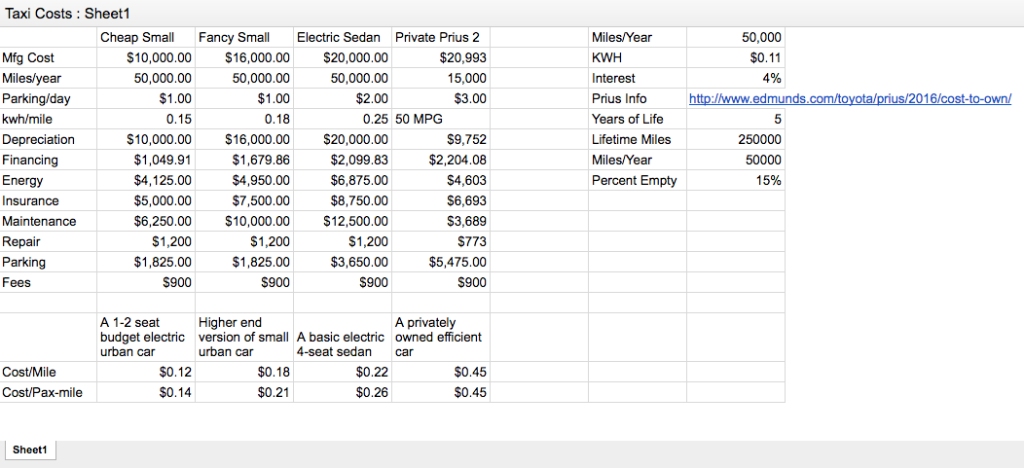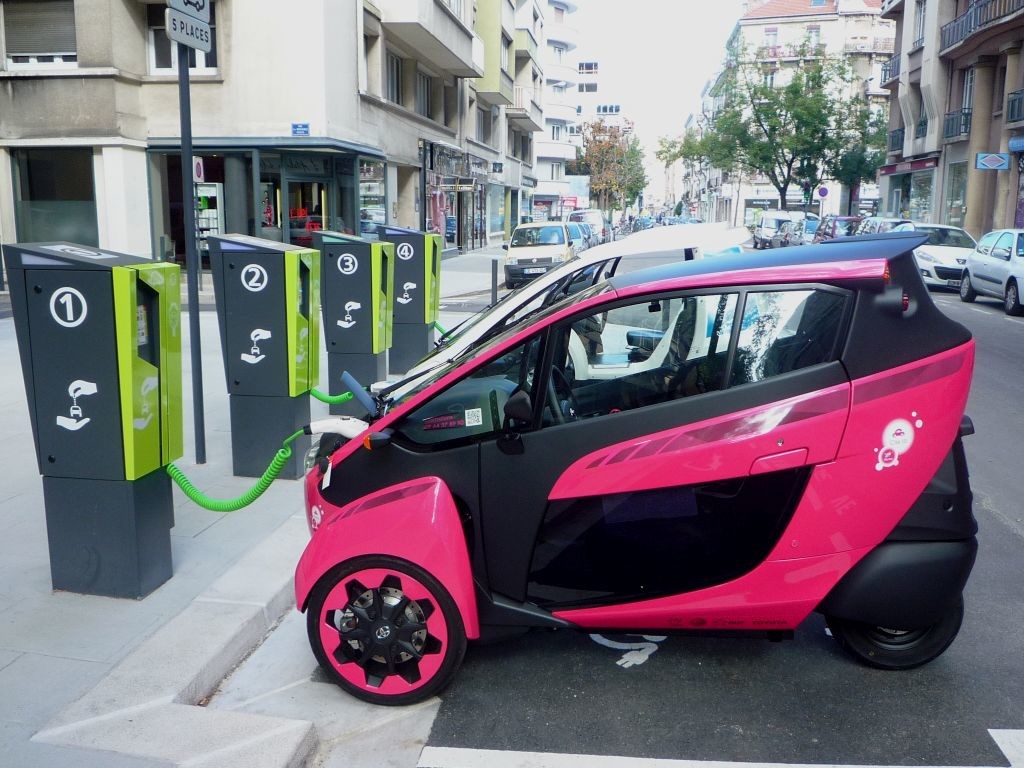
Robohub.org
Breaking down robotaxi economics
The vision of many of us for robocars is a world of less private car ownership and more use of robotaxis — on-demand ride service in a robocar. That’s what companies like Uber clearly are pushing for, and probably Google, but several of the big car companies including Mercedes, Ford and BMW among others have also said they want to get there — in the case of Ford, without first making private robocars for their traditional customers.
In this world, what does it cost to operate these cars? How much might competitive services charge for rides? How much money will they make? What factors, including price, will they compete on, and how will that alter the landscape?
Here are some basic models of cost. I compare a low-cost 1-2 person robotaxi, a higher-end 1-2 person robotaxi, a 4-person traditional sedan robotaxi and the costs of ownership for a private car, the Toyota Prius 2, as calculated by Edmunds. An important difference is that the taxis are forecast to drive 50,000 miles/year (as taxis do) and wear out fully in 5 years. The private car is forecast to drive 15,000 miles/year (higher than the average for new cars, which is 12,000) and still have many years and miles of life left in it. As such, the taxis fully depreciate in this 5-year timeline, the private car only partly.
Some numbers are speculative. I am predicting that the robotaxis will have an insurance cost well below today’s cars, which cost about 6 cents/mile for liability insurance. The taxis will actually be self-insured, meaning this is the expected cost of any incidents. In the early days, this will not be true — the taxis will be safer, but the incidents will cost more until things settle down. As such the insurance prices are for the future.
Fuel is electric for the taxis, gasoline/hybrid for the Prius. The light vehicle is very efficient.
Maintenance is also speculative. Today’s cars spend about 6 cents/mile, including 1 cent/mile for the tires. Electric cars are expected to have lower maintenance costs, but the totals here are higher because the car is going 250,000 miles not 75,000 miles like the Prius. With this high level of maintenance and such smooth driving, I forecast low repair cost.
Parking is cheaper for the taxis for several reasons. First, they can freely move around looking for the cheapest place to wait, which will often be free city parking or the cheapest advertised parking on the auction “spot” market. They do not need to park right where the passenger is going, as the private car does. They will park valet style, and so the small cars will use less space and pay less too. Parking may actually be much cheaper than this, even free in many cases. Of course, many private car owners do not pay for parking overtly so this varies a lot from city to city.

(You can view the spreadsheet directly on Google docs and download it to your own tool to play around with the model.)
The Prius has one of the lowest costs of ownership of any regular car (take out the parking and it’s only 38 cents/mile) but its price is massively undercut by the electric robotaxi, especially my estimates for the half-width electric city car. (I have not even included the tax credits that apply to electric cars today.) For the taxis, I add 15% vacant miles to come up with the final cost.
The price of the Prius is the retail cost (on which you must also pay tax) but a taxi fleet operator would pay a wholesale, or even manufacturer’s cost. Of course, they now have the costs of running a fleet of self-driving cars. That includes all the virtual stuff (software, maps and apps) with websites and all the other staff of a big service company ranging from lawyers to marketing departments. This is hard to estimate because if the company gets big, this cost will not be based on miles, and even so, it will not add many cents per mile. The costs of the Prius for fuel, repair, maintenance and the rest are also all retail. The taxi operator wants a margin, and a big margin at first, though with competition this margin would settle to that of other service businesses.
So, what will the price be of your robocar ride? Today, an Uber ride tends to be a mix of a “per ride” fee (which hopefully covers the cost of getting to you) and about $1 to $1.50 per mile and about $13/hour in the USA. (In Peru it’s $3.60 per hour and just 40 cents/mile.) Depending on your speed, USA UberX will cost you $2 to $2.50 per mile. As such, $1/mile would be a very attractive, but also very profitable introductory price.
Competition should drive prices down to more normal margins. Typical gross profits in transportation are 50%. This suggests from 20 to 25 cents/mile for the urban solo ride up to 50 cents/mile for the 4 passenger sedan (or just 12 cents/mile/person if you fill it up or carpool in it.) This means the small car at 25 cents/mile has revenues of only $35/day (around $12,500 per year) with COGS of $16/day. I have not factored in per-ride fees or trip minimums, which are normal in Taxi/Uber services. (The Uber $5 trip minimum covers a whopping 20 miles in this car.) I expect trip minimal to drop to compete with $2.50 transit tickets, especially when pooling.
Google runs a gross margin that’s very high (about 67%) but on the other end consider that Uber (though not profitable yet) takes 20% of its gross cost of a ride (and pays its own expenses from that.)
What are these small cars?
I describe a number of ways a 1-2 person robotaxi might be very cheap in this article. Let’s go into more detail on why it might get manufactured for around $10K (retail would be higher.) Note that there are already many low-end 4 person gasoline cars which retail around $14,000 such as the Nissan Versa and Chevy Spark. Outside the USA, there are even cheaper cars, like the $8,000 Renault Twizzy. Some of these cars are full-width and come with dashboards full of stuff, pedals, wheels, doors, hatchbacks and more. They meet crash-safety standards and the rest of the FMVSS.
The basic commuter car will be:
- Just over half the width and under 2/3 the length of these cars
- Weigh perhaps half of those cars, using far less materials
- Have no dashboard, no radio, no pedals, no wheel
- Have only one door instead of 3 or 4, and no trunk (just an internal cargo area)
- Have only 1-2 seats (with associated airbags and components)
- Have vastly fewer parts
- In the urban version, not go over 45mph, allowing a low-cost motor
What it will have is a battery pack. At 100 watt-hours/mile, a 10kwh battery would give it 100 miles of range, more than enough with recharging breaks during the day to cover the average of 140 miles/day it will do as an urban taxi. The forecast cost of $150/kwh puts that pack at $1,500. Expensive, but when combined with the much simpler electric motor powertrain, a reasonable cost.
It will also have about $1,000 of sensors and computers in it. These prices get this low because these vehicles are made in the many hundreds of thousands, and eventually millions. It also has a few things not found in cheap cars, like a single power door lock.
The higher-end vehicle at $16,000 is pretty similar in design, but the extra money goes into making it more luxurious:
- Better seats and interior materials, replaced more often
- Better suspension for smoother ride
- Better sound padding
- A screen and sound system, or better ones than in the base vehicle
- A distinctive exterior with better styling and fancier paint, to let people see you are in the higher end vehicle.
- Power windows. (Both cars have power locks, and neither car need seat position adjustments.)
- Some fancier interior furniture (tables, drink holders, laptop holders etc.)
- Possibly a motorized door for easy entry (one of the more expensive add-ons)
- Possibly a sunroof (but there will also be open-top cars for order if you want them and the weather is good.)
When I have examined the lists of luxury features on high-end cars, I have been surprised at how few of them are needed in the luxury robocar. Driver assist functions, 10-way motorized seats, motorized mirrors, telescoping steering wheels, fancy wheels, fancy lights and many other features play no role in the robotaxi.
My numbers are aggressive — so if you doubt them, increase them. The result is still a robotaxi at a low per-mile operating and capital cost, which means in a competitive market, it will be available at a price that easily competes with private car ownership, and even subsidized bus rides.
tags: Automotive, Autonomous Cars, Brad Templeton, robocars, robotaxi





